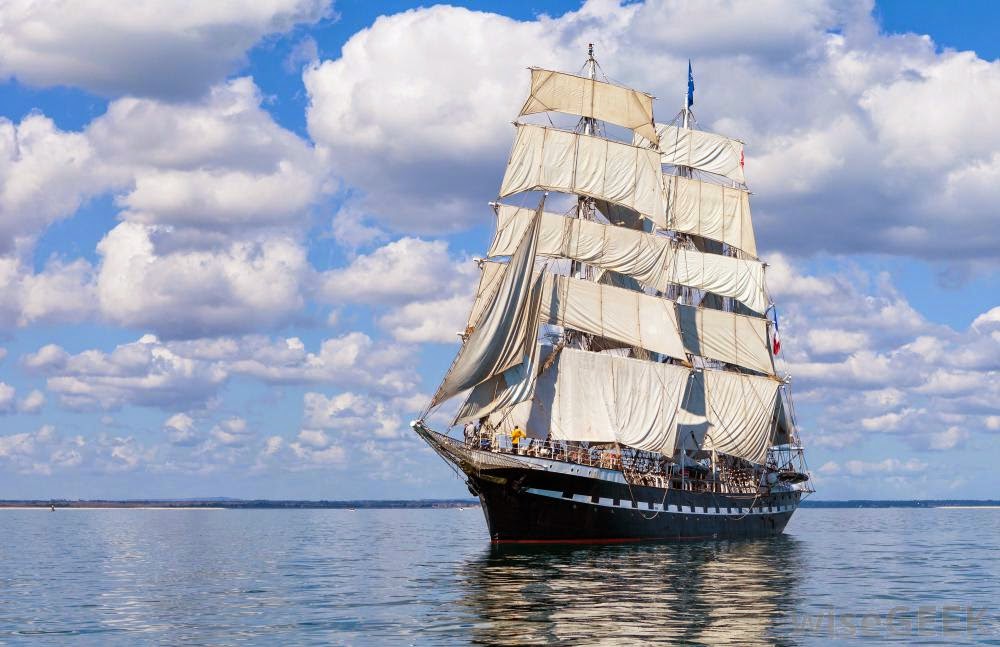by Ted Brooks
One of the many wonders of the Bible and immutable
testimony to its ‘God breathed’ nature is its appeal and revelation to so many diverse
in culture, background, life experience, etc. Through prose, simile, metaphor,
allegory and illustration God’s message has been conveyed to us on many
different levels.
In biblical times, ships were a primary means of
commerce, communication, transportation, and provision throughout the known
world. Nations with the best merchant fleets, naval military fleets, and
fishing fleets were the most profoundly influential in the expanding civilization.
It should be no surprise that to those who plied the Mediterranean and its
associated waterways in pursuit of livelihood, key passages of the Bible spoke
in unique tones that resonate in our hearts even today. I would hope to convey to
you a mariner’s understanding of a few key passages of the Bible, and to draw
parallels between ships and their crew, and the church family and its members.
“Enter ye in at the strait gate: for wide is the gate, and broad is
the way, that leadeth to destruction, and many there be which go in thereat:
Because strait is the gate, and narrow is the way which leadeth unto life, and
few there be that find it” (Matthew 7:13,14). And again as
restated in (Luke 13:14) “Strive
to enter in at the strait gate; for many I say unto you, will seek to enter in
and shall not be able.”
Strait means narrow…to a mariner a strait (s-t-r-a-i-t)
is a narrow passage between two larger
bodies of water such as between two
lakes, two seas, or a sea and an ocean. For example, The Strait of Gibraltar,
The Bosporus or Turkish Strait, the Dardanelles, Black Sea Strait, or the
Straits of Hormuz between the Persian Gulf and the Gulf of Oman near Saudi
Arabia.
 |
| Satellite view of the Strait of Gibraltar copyright, NASA |
A strait is not straight. A strait is usually a tortuous,
confined passage, often bordered by shoals or shallows sometimes additionally obstructed
by wrecks of vessels less fortunate or more careless. Currents are normally
exaggerated and sea levels change with the tides alternately exposing and
concealing the dangers. Sea state and
situation changes quickly and constant vigilance is critical. Because these
straits typically join larger seaways they form natural chokepoints, which
figure prominently in naval strategy, law enforcement, and pirate activity. If
a ship is to transit these regions, the crew must be prepared for not just
fixed navigation hazards but also bad sea state, hostile weather, and
potentially hostile ships as well.
A strait gate is a narrow gate…and though a gate in
this sense is often construed as an opening in a wall that can typically be
closed, to a seaman, a gate, or Seagate is the entrance to a harbor or port.
How secure that harbor is often depends on how narrow or strait that gate is. A
closed harbor is protected from storms and sea waves, which can damage ships
and the seaport itself. A narrow sea gate is more readily closed and defended
against the raging sea or against sea marauders than an otherwise open or
exposed inlet or harbor. The opening in the barrier is typically at the deepest
point in the harbor entrance usually formed by river runoff into the sea and
referred to as a channel. A channel is often bordered by flats or shallows on
either side referred to as shoals. Often the channel meanders across the
approach and often it shifts over time. Constant care is required to ensure it
is clearly marked to prevent ships from missing or leaving the channel and
running aground entering or leaving port.
The term “way,” to the mariner, refers to the sea
path accepted as safe for navigation through a region or to a location. To a
seafarer the broad way is only safe far away from the shore where a navigator
can rely on good water under the keel. Knowing where you are is critical to your
arrival at destination. The closer to port you get, the more dangerous and
deceptive the broad way gets and the more critical it becomes to know how to
stay in the channel or “narrow way.” Any mariner need only look at a navigation
chart and observe the submerged wreckage and obstructions marked thereon to
realize this.
Our walk with Christ is not easy, and it only
begins at baptism. All along the way, we can be drawn away by distraction and
diversions often not recognized until we have lost our way. Then we risk
becoming another lost soul or another spiritual wreck on the chart. Just as the
“strait gate” and “narrow way” are the only way
to enter safe harbor, so it is with the way we choose in our Christian walk. And, just as it would be unwise to enter the
port of Alexandria when the cargo was intended for the port of Haifa…Not only
is the way we choose critical but the destination...only the right port will
offer us success in our effort.
“There is one body, and one Spirit, even as ye are called in one
hope of your calling; One Lord, one faith, one baptism, One God and Father of
us all, who is above all, and through all, and in you all.” (Eph. 4:4-6)
image: courtesy of http://images.wisegeek.com/clipper-ship-in-front-of-cloudy-sky.jpg
image:NASA http://www.esa.int/spaceinimages/Images/2012/01/The_Strait_of_Gibraltar_as_seen_from_the_ISS
image:NASA http://www.esa.int/spaceinimages/Images/2012/01/The_Strait_of_Gibraltar_as_seen_from_the_ISS
